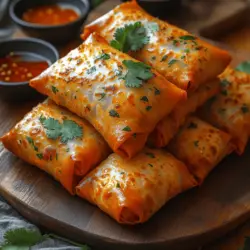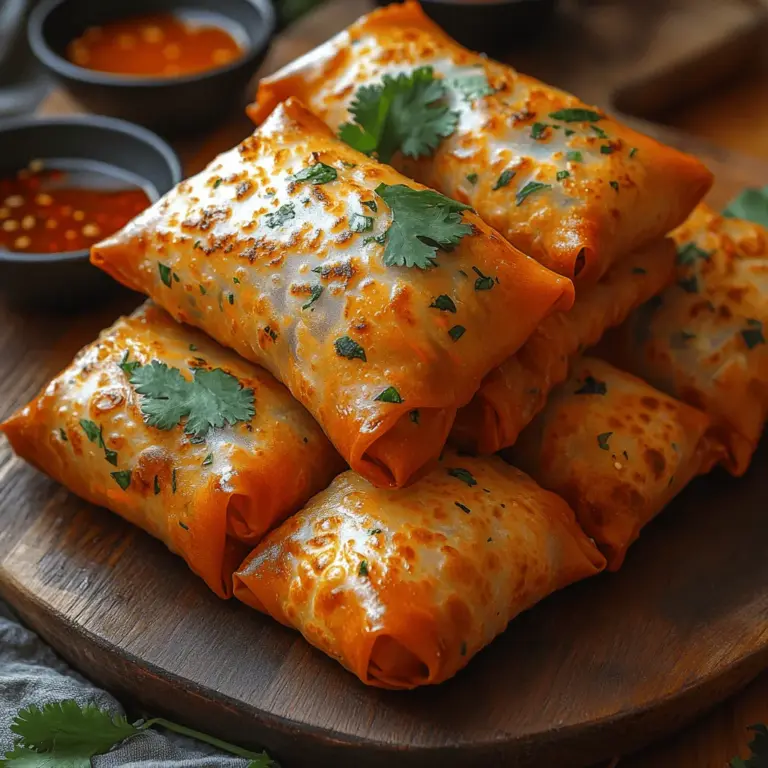Introduction to the Delight of Homemade Spring Rolls
The allure of homemade spring rolls lies not just in their crispy texture and savory filling but also in the rich tradition they represent within Chinese cuisine. These delectable bites, golden and crunchy, serve as a versatile dish that can be enjoyed in various contexts—whether as an appetizer at a festive gathering, a satisfying snack during a casual meal, or even as the centerpiece of a main course.
Making Classic Chinese Spring Rolls is a culinary adventure that promises both satisfaction and fun. As you prepare this recipe, you will engage in a time-honored technique that has been cherished for generations. The combination of fresh vegetables, wrapped in delicate spring roll wrappers and fried to perfection, creates a mouthwatering experience that tantalizes the taste buds and delights the senses.
Understanding the Origins of Spring Rolls
To truly appreciate the joy of crafting your own spring rolls, it’s essential to understand their fascinating history. Spring rolls are believed to have originated in ancient China, dating back to the Eastern Jin dynasty (317-420 AD). These early iterations were simple flatbreads filled with spring vegetables, symbolizing the arrival of spring and the renewal of life after a long winter.
As trade routes expanded and culinary influences began to intertwine, spring rolls evolved. They transitioned from a humble dish to a beloved staple in Chinese cuisine, adapting to regional preferences and available ingredients. In contemporary cooking, spring rolls are celebrated worldwide, often featuring a variety of fillings that reflect local tastes—from shrimp and pork to vegetarian options bursting with fresh produce.
This evolution showcases the adaptability of spring rolls, making them a cherished dish that resonates across cultures, each bite telling a story of tradition and innovation.
The Nutritional Benefits of Spring Rolls
Beyond their delightful taste and texture, Classic Chinese Spring Rolls also offer several nutritional benefits. The primary ingredients—cabbage, carrots, and bean sprouts—are not only accessible but also packed with nutrients that contribute to a balanced diet.
– Cabbage: A key component of the filling, cabbage is rich in vitamins C and K, while being low in calories. This cruciferous vegetable is known for its antioxidant properties and potential to support digestive health.
– Carrots: Adding a touch of sweetness and vibrant color, carrots are an excellent source of beta-carotene, which the body converts into vitamin A. This nutrient is crucial for maintaining healthy vision, skin, and immune function.
– Bean Sprouts: These tiny but mighty ingredients are low in calories yet high in protein and essential vitamins. Bean sprouts are particularly noted for their ability to enhance digestion and boost energy levels.
By integrating these fresh ingredients, Classic Chinese Spring Rolls not only satisfy your cravings but also contribute positively to your overall health. This makes them an excellent choice for anyone looking to indulge without compromising their nutritional goals.
Gathering Your Ingredients: What You’ll Need
Before embarking on the journey of making your own Classic Chinese Spring Rolls, it’s vital to gather all the necessary ingredients. Here’s a comprehensive list that will ensure your spring rolls are bursting with flavor and freshness:
Ingredients List:
– Spring Roll Wrappers: Look for thin, delicate wrappers specifically labeled for spring rolls or egg rolls. Fresh wrappers are preferable, but frozen options work well too—just ensure they are thawed before use.
– Fresh Cabbage: Choose a firm head of green cabbage. It should feel heavy for its size and have crisp, vibrant leaves.
– Carrots: Select firm, unblemished carrots. Organic carrots are an excellent choice if available, as they usually have a more robust flavor.
– Bean Sprouts: Fresh bean sprouts should be crisp and white with healthy green tips. Avoid sprouts that are slimy or discolored.
– Onion: A medium-sized onion, either yellow or green, will add depth to the filling.
– Garlic: Use fresh garlic cloves for a punch of flavor.
– Oyster Sauce (optional): This sauce adds umami and richness to the filling. If you prefer a vegetarian option, substitute with a plant-based alternative.
– Sesame Oil: A few drops of toasted sesame oil will enhance the overall flavor profile of the filling, imparting a nutty aroma.
– Salt and Pepper: Essential for seasoning the filling to taste.
Selecting the Best Produce
When choosing your vegetables, freshness is key. Opt for vibrant, unblemished produce, ideally sourced from local markets or organic vendors. Fresh ingredients not only enhance the flavor and texture of your spring rolls but also contribute to their nutritional value.
Step-by-Step Guide to Preparing Classic Chinese Spring Rolls
Now that you have gathered all your ingredients, it’s time to delve into the preparation process. Making Classic Chinese Spring Rolls may seem daunting at first, but with clear steps and a little practice, you’ll soon be rolling out these crispy delights with confidence.
Preparing the Filling
1. Chop the Vegetables: Start by finely chopping the cabbage, carrots, and onion. The smaller the pieces, the easier it will be to roll the spring rolls and ensure even cooking. For the carrots, you can use a grater for a finer texture, which blends beautifully with the other ingredients.
2. Sauté the Ingredients: In a large skillet or wok, heat a tablespoon of oil over medium heat. Add the chopped onion and minced garlic, sautéing until they become fragrant and translucent. This should take about 2-3 minutes.
3. Add the Cabbage and Carrots: Once the onion is ready, add the chopped cabbage and carrots to the skillet. Stir-fry the mixture for about 5-7 minutes, or until the vegetables are tender yet still crisp.
4. Incorporate Bean Sprouts: Add the fresh bean sprouts to the skillet. These should be cooked for only a minute or so, just enough to warm them through while retaining their crunch.
5. Season the Filling: Drizzle in the oyster sauce and sesame oil, then sprinkle salt and pepper to taste. Stir the mixture well, ensuring all the vegetables are coated in the seasoning. Remove the skillet from heat and let the filling cool slightly before using it to fill the wrappers.
—
With the filling prepared, you are now ready to assemble your Classic Chinese Spring Rolls. Stay tuned for the next part, where we will explore the techniques and tips for rolling and frying these delightful treats to perfection.

The Importance of Mixing Vegetables and Seasonings
Achieving the perfect flavor and texture in your Classic Chinese Spring Rolls hinges on how well you mix your vegetables and seasonings. Properly combining these elements ensures that each bite bursts with flavor while maintaining the desired crunchiness. Start with fresh, crisp vegetables—think cabbage, carrots, and bell peppers. Chop them finely to ensure they cook evenly and fit snugly inside the wrapper.
Don’t forget to season your filling adequately. A blend of soy sauce, sesame oil, and perhaps a hint of freshly grated ginger can elevate your spring rolls from ordinary to extraordinary. The key is to mix these ingredients thoroughly, allowing the vegetables to absorb the flavors. If you’re looking to add protein, consider incorporating shrimp or chicken. For shrimp, a quick sauté with garlic and a splash of soy sauce will enhance their flavor. If you opt for chicken, cook and shred it before tossing it with your vegetables and seasonings. This addition not only boosts the nutritional value but also adds a delightful heartiness to your spring rolls.
Mastering the Art of Wrapping
Now that you have your vibrant filling ready, it’s time to master the art of wrapping. The technique used to wrap your spring rolls is crucial for ensuring they are tightly sealed and won’t open during frying. Begin by laying a spring roll wrapper on a flat surface, with one corner pointing toward you. Spoon a small amount of filling (about two tablespoons) in a line along the center of the wrapper, leaving about an inch of space at the edges.
To wrap, fold the corner closest to you over the filling and roll it tightly away from you, tucking in the sides as you go. This creates a tight seal, preventing the filling from spilling out. Use a bit of water to moisten the edges of the wrapper before sealing it completely; this helps the edges adhere to one another. Finally, ensure the roll is snug without being overly tight, as this will allow the filling to expand slightly during frying.
Frying Techniques for Perfectly Crispy Rolls
Frying your spring rolls to golden perfection requires attention to oil temperature and cooking techniques. The ideal frying oil should be heated to around 350°F (175°C). Using a kitchen thermometer can help you maintain this temperature accurately. If the oil is too cold, the spring rolls will absorb excess oil, resulting in soggy wrappers. Conversely, if the oil is too hot, they may burn before the insides are cooked through.
When frying, it’s crucial not to overcrowd the pan. Frying in batches allows the temperature of the oil to remain constant, resulting in evenly cooked spring rolls. Each batch should take about 3-4 minutes to achieve that desirable golden-brown color. Use a slotted spoon to turn them occasionally, ensuring even frying on all sides. Once cooked, transfer the spring rolls to a plate lined with paper towels to absorb any excess oil, keeping them crispy.
Serving Suggestions and Pairings
Once your Classic Chinese Spring Rolls are perfectly fried and ready to serve, consider elevating your dining experience with complementary dipping sauces. A classic sweet and sour sauce adds a tangy contrast, while soy sauce offers a savory depth that enhances the flavors of the spring rolls. For a bit of heat, try a chili garlic sauce or sriracha mixed with soy sauce for an extra kick.
In terms of side dishes, a light cucumber salad or steamed jasmine rice pairs wonderfully with spring rolls. For beverages, consider serving green tea or a light lager, both of which complement the flavors of the rolls beautifully. These combinations can create a well-rounded meal that satisfies all palates.
Troubleshooting Common Issues When Making Spring Rolls
Even experienced cooks can encounter challenges when making spring rolls. Here are some common issues and practical solutions to ensure your cooking experience is smooth and successful:
– Soggy Wrappers: This often occurs when the filling is too wet. To prevent this, ensure you thoroughly drain any excess moisture from your vegetables before mixing them with the seasonings. Additionally, avoid overfilling the wrappers, as this can lead to moisture seeping through during frying.
– Uneven Frying: If your spring rolls cook unevenly, it’s likely due to overcrowding the pan. As mentioned earlier, frying in small batches allows for consistent cooking. Also, ensure the oil temperature is maintained throughout the frying process.
– Wrappers Breaking: If your wrappers crack or break while wrapping, they may be too dry. Keep the wrappers covered with a damp cloth while you work to prevent them from drying out. If they are too wet, they can become slippery, making them difficult to handle.
Conclusion: The Joy of Sharing Homemade Spring Rolls
Homemade Classic Chinese Spring Rolls are more than just a delightful dish; they embody the joy of sharing and creating memories with family and friends. The communal aspect of enjoying these crispy delights around the dining table fosters connection and conversation. Each spring roll represents a labor of love, from selecting the freshest ingredients to mastering the wrapping technique and perfecting the frying process.
Encourage your loved ones to join you in the kitchen, making the preparation of spring rolls a fun and interactive experience. Cooking together not only builds bonds but also allows everyone to contribute their unique touches to the dish. As you savor these homemade spring rolls, remember that the process is just as rewarding as the final product. Embrace the art of cooking, and let your culinary creations bring people together, creating cherished moments that will last a lifetime.

